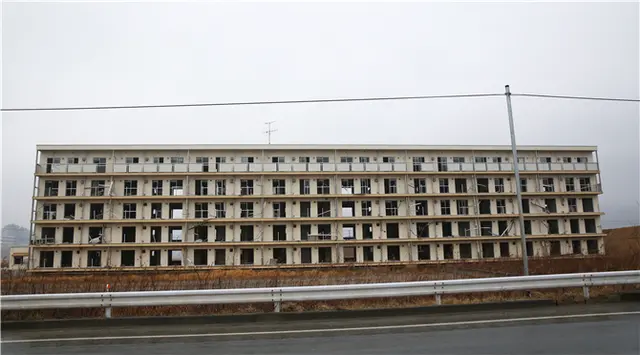The nation came to a standstill at 2:46 p.m. on Friday for a minute's silence, exactly five years after a magnitude-9.0 earthquake struck off the coast of Japan's eastern seaboard triggering a killer tsunami that devoured swathes of land particularly in the northeast Tohoku region and combined with a nuclear calamity sparked in the aftermath, claimed nearly 16,000 innocent lives with 2,561 still unaccounted for and presumed dead.
Along with mourners convening the length and breadth of the country, Japanese Prime Minister Shinzo Abe attended a state-sponsored memorial service held at the National Theater and along with Emperor Akihito paid respects to the thousands of lives lost in the days, weeks, months and years after the triple disasters, that saw the quake, one of the most powerful on record in Japan and the monstrous tsunami it triggered with waves as high as 40 meters, combined with the ongoing Fukushima nuclear crisis, the worst commercial disaster in history, contrive to mercilessly destroy land, lives and families, leaving many still grappling with health, housing and dire economic woes.
While the memories of that fateful day five years ago remain fresh in the minds of a nation, and work has progressed to rebuild towns and cities along the eastern seaboard, in some instances on higher ground above sea level with towering tsunami walls being built along coastlines, questions are still being asked, however, half a decade on, about the pace of the overall reconstruction work and the safety of the government's plans to bring the nation' s comparatively ancient idled reactors back online.
Among three of the worst-hit regions in Tohoku were Fukushima, Iwate and Miyage Prefectures where 174,000 people remain displaced, 43,000 of whom are from Fukushima, but have failed to return in the wake of the nuclear crisis there that has yet to be brought under control by the utility's operator Tokyo Electric Power Co. (TEPCO), who is struggling to contain massive quantities of contaminated water at the site that houses its battered and faulty reactors, the overall decommissioning of which is expected to take decades longer.
Of those displaced in the region, some 57,677 people are still, somewhat inconceivably, living in prefabricated makeshift housing half a decade on, according to the latest statistics.
With three of TEPCO's former executives being indicted at the end of last month on charges of professional negligence for their failure to take the appropriate measures that could have prevented the nuclear disaster at the Fukushima Daiichi nuclear power plant, and a district court this week forcing the nation's second-largest utility Kansai Electric Power Co. to halt operations at two of its reactors at its Takahama plant on the Sea of Japan in Fukui Prefecture, citing safety concerns pertaining to a lack of emergency protocols to deal with a Fukushima-like tsunami strike, concerns are mounting about the government's steadfast nuclear policy.
The prime minister told a press conference on the eve of the fifth anniversary of the March 11 triple disasters, that as Japan was a resource poor nation, the use of nuclear power would be an indispensable part of the government's energy policy looking ahead, which has set a target of 20 percent of the nation's total energy production coming from nuclear power by 2030 and necessitates the rebooting of the majority of the nation's reactors, some of the oldest in the world still online yet shuttered in the wake of the Fukushima disaster for safety checks, to achieve this.
Officials in the disaster-hit regions including in Fukushima, along with stating that reconstruction delays have severely contributed to local people's ongoing suffering, with instances of physical and mental health issues sharply spiking, as evidenced by the rise in suicides, particularly among the elderly, who are desperate to return to their ancestral land and rebuild family homes evacuated for radiation or washed away by the tsunami but can ill-afford to do so, have recently voiced concern that essential funds earmarked for revitalization work in the northeast may be reprioritized for construction projects related to the highly-lucrative Tokyo 2020 Olympic Games.
The Games is a light of economic hope on an otherwise bleak horizon for the central government here who is currently dealing with slumping GDP as domestic consumption and exports both wane, and a surefire means to bring in overseas revenue to combat the nation's protracted economic malaise.
These concerns come as the government has earmarked 6.5 trillion yen (57.38 billion U.S. dollars) for reconstruction work over a five-year period beginning next month, which Abe has designated as a "reconstruction creation period,"yet now local municipalities themselves, already struggling from shrinking populations, workforces and markets, will have to share some of the financial burden of these costs.
Such costs for local governments will likely increase in line with the government's broader plan to spend a total of 32 trillion yen (282.49 billion U.S. dollars) over the decade from 2020 for disaster-linked reconstruction, although, it would seem, how much cash the state purportedly throws at this monumental problem and how much of it actually sticks, are two entirely different propositions, as evidenced by the myriad financial, construction and rehousing delays hindering revitalization work over the past five years.
It likely taking decades not years until the Tohoku region once again resembles its former, pre-disaster vibrant self, remains the stark, unimaginable, yet, dismal reality of the situation on this somber anniversary in the world's third-largest economy.
 简体中文
简体中文

